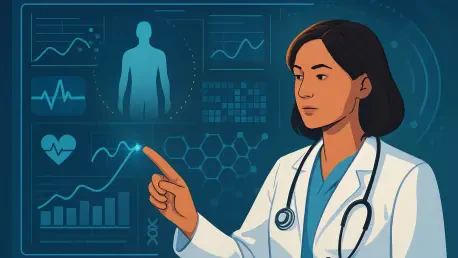In an era where healthcare demands precision and efficiency, predictive care stands out as a groundbreaking approach that is reshaping outpatient services with remarkable potential. By integrating advanced technologies like machine learning and real-time data analytics, these innovative platforms enable healthcare providers to foresee potential health issues before they escalate into critical conditions. This proactive stance marks a significant departure from traditional reactive models, particularly in outpatient settings where timely interventions can drastically reduce the need for hospitalizations and enhance patient outcomes. The ability to anticipate rather than merely respond to health challenges is not just a technological advancement but a fundamental shift in how care is delivered. This transformation touches on clinical practices, patient engagement, and operational workflows, creating a more responsive and patient-centered healthcare landscape that prioritizes prevention over crisis management.
The Power of Data-Driven Healthcare
Harnessing Data for Early Intervention
Predictive care’s strength lies in its capacity to aggregate and analyze a wide array of data sources, paving the way for early detection of health concerns. Platforms draw from Electronic Health Records (EHRs), wearable device metrics, lab results, and patient-reported data to uncover subtle patterns that might indicate a decline in health. This is particularly vital for chronic conditions like diabetes or cardiovascular diseases, where minor fluctuations in vital signs can serve as early warnings. By identifying these trends, healthcare providers can step in with targeted interventions long before a situation becomes urgent. The result is a significant reduction in emergency room visits and hospital admissions, which not only improves patient well-being but also alleviates pressure on overburdened healthcare systems. This data-centric approach ensures that care is not just reactive but strategically anticipatory, focusing on maintaining health rather than merely treating illness.
The impact of early intervention extends beyond individual patients to broader healthcare economics. When predictive tools flag potential issues early, the need for costly acute care diminishes, allowing resources to be allocated more effectively. For instance, a patient with a slowly worsening respiratory condition might receive adjusted medication or lifestyle recommendations before a full-blown crisis emerges. This not only saves on expensive treatments but also enhances the quality of life for patients who can avoid the distress of emergency interventions. Moreover, the continuous monitoring enabled by wearable technology means that data is updated in real time, offering a dynamic view of a patient’s health status. Such immediacy empowers clinicians to make informed decisions swiftly, ensuring that no critical detail slips through the cracks. This seamless integration of technology and clinical insight forms the bedrock of a more resilient outpatient care model.
Unlocking Insights Through Advanced Analytics
Beyond the immediate benefits of early detection, predictive care platforms utilize advanced analytics to refine their forecasting abilities over time. Machine learning algorithms adapt to individual patient profiles, learning from historical data to improve the accuracy of health predictions. This adaptability means that as more data is collected, the system becomes increasingly adept at recognizing unique risk factors for each person. For patients with complex medical histories, this personalized approach can be a game-changer, ensuring that care plans are tailored to specific needs rather than relying on generalized protocols. The continuous evolution of these algorithms also keeps pace with advancements in medical research, incorporating new findings to enhance their predictive power. This dynamic process ensures that outpatient care remains at the forefront of innovation, consistently aligned with the latest clinical standards.
The role of analytics in predictive care also extends to identifying broader health trends that can inform preventive strategies. By analyzing data across diverse patient populations, these platforms can highlight common risk factors that might otherwise go unnoticed. For example, a spike in certain symptoms across a geographic area might prompt targeted public health campaigns or resource adjustments to address an emerging issue. This level of insight allows healthcare providers to move beyond individual care to proactive community health management. Additionally, the integration of real-time data ensures that predictions are not static but evolve with a patient’s current condition, offering a living snapshot of health risks. Such precision fosters confidence among providers, who can rely on these tools to guide their decision-making with evidence-based recommendations, ultimately strengthening the foundation of outpatient services.
Enhancing Patient and Provider Collaboration
Empowering Patients and Supporting Clinicians
Predictive care is redefining the dynamic between patients and healthcare providers by fostering a collaborative environment rooted in personalized insights. These platforms translate complex health data into user-friendly formats, enabling patients to grasp their health risks and progress with clarity. This transparency encourages active participation in care plans, as individuals gain a sense of ownership over their wellness journey. For providers, decision-support tools integrated into predictive systems offer actionable recommendations based on real-time data and forecasted outcomes. This dual empowerment ensures that both parties are equipped with the knowledge needed for informed decision-making. The result is a stronger partnership, where patients adhere more closely to treatment plans and providers can deliver care that is both precise and empathetic, ultimately enhancing health outcomes.
This collaborative model also addresses common challenges in outpatient care, such as missed appointments and poor treatment adherence. By sending timely alerts and reminders based on predictive insights, these platforms help patients stay engaged with their care schedules. For instance, a patient at risk of a health setback might receive a notification to follow up with their provider, preventing a lapse in care. On the clinician’s side, access to comprehensive data visualizations allows for more meaningful consultations, where discussions are grounded in specific, evidence-based insights rather than general assumptions. This targeted approach not only saves time but also builds trust, as patients feel their unique needs are being prioritized. The synergy created by predictive care tools thus transforms routine interactions into opportunities for proactive health management, reinforcing the importance of communication in achieving lasting wellness.
Building Trust Through Shared Decision-Making
A key benefit of predictive care lies in its ability to cultivate trust through shared decision-making, a cornerstone of modern healthcare. When patients have access to clear, data-driven insights about their health, they are more likely to engage in conversations with providers about their treatment options. This openness fosters a sense of partnership, where decisions are made collectively rather than imposed. Providers, supported by predictive tools, can present evidence-based rationales for recommended interventions, ensuring that patients understand the reasoning behind each step. This transparency is especially critical for individuals managing long-term conditions, who often face complex care pathways. By involving them in the process, predictive care helps demystify medical advice, making it more relatable and actionable, which in turn boosts confidence in the healthcare system.
Furthermore, shared decision-making supported by predictive care has a tangible impact on patient satisfaction and outcomes. When individuals feel heard and understood, their commitment to following through with care plans strengthens, reducing the likelihood of setbacks. For example, a patient with a predicted risk of cardiovascular issues might work with their provider to adjust lifestyle factors, knowing that the advice is backed by personalized data. This collaborative effort not only mitigates health risks but also enhances the emotional well-being of patients, who feel supported rather than dictated to. On a systemic level, this approach helps reduce the burden of preventable complications, as engaged patients are less likely to require intensive interventions. Predictive care, by facilitating these meaningful interactions, lays the groundwork for a healthcare model that values mutual respect and understanding as much as clinical expertise.
Optimizing Outpatient Operations
Streamlining Workflows and Resource Allocation
From an operational standpoint, predictive care offers a powerful solution for enhancing the efficiency of outpatient services by anticipating patient needs with precision. These platforms analyze historical and real-time data to forecast patient volumes and service demands, allowing healthcare organizations to optimize staffing and scheduling. For instance, a clinic might adjust provider availability based on predicted peaks in appointment needs, ensuring that resources are neither underutilized nor overwhelmed. This foresight minimizes bottlenecks, reduces wait times, and ensures that high-risk patients receive priority attention when needed. By aligning resources with actual demand, predictive care helps create a smoother, more responsive care delivery system that benefits both patients and staff, maintaining a high standard of service even during high-pressure periods.
The operational advantages of predictive care also translate into cost savings and improved staff satisfaction. When workflows are streamlined through accurate demand predictions, healthcare facilities can avoid the inefficiencies of overstaffing or the stress of understaffing during unexpected surges. This balance allows clinical teams to focus on delivering quality care rather than grappling with logistical challenges. Additionally, by identifying which patients require urgent interventions, predictive tools ensure that expertise is directed where it is most impactful, preventing resource waste on less critical cases. This targeted allocation not only enhances patient outcomes but also reduces burnout among providers, who can work within a more manageable and predictable framework. The ripple effect of such efficiency is a healthcare environment where operational excellence supports clinical goals, creating a sustainable model for outpatient services.
Prioritizing High-Risk Cases for Maximum Impact
Another critical aspect of predictive care in operations is its ability to prioritize high-risk cases, ensuring that limited resources are used to maximum effect. By analyzing patient data, these platforms can identify individuals who are most likely to experience health declines, flagging them for immediate attention. This risk stratification allows outpatient facilities to allocate appointments, follow-ups, and interventions strategically, focusing on prevention for those at greatest risk. For example, a patient with early indicators of a potential cardiac event might be fast-tracked for diagnostic testing and counseling, averting a more serious outcome. This proactive focus not only saves lives but also optimizes the use of medical resources, ensuring that care is delivered equitably and efficiently across a diverse patient population.
The emphasis on high-risk prioritization also supports long-term planning within outpatient settings. Predictive care tools provide insights into recurring patterns of health risks, enabling facilities to prepare for seasonal or demographic trends that might increase demand for specific services. For instance, a rise in respiratory issues during colder months could prompt preemptive allocation of specialists and equipment. This forward-thinking approach reduces the strain of sudden spikes in need, allowing clinics to maintain consistent care quality. Furthermore, by addressing high-risk cases early, healthcare systems can prevent the cascading costs associated with emergency care and hospitalizations, redirecting funds toward preventive and routine services. Predictive care thus serves as a linchpin for operational resilience, ensuring that outpatient facilities are not just reacting to crises but actively shaping a healthier future for their communities.
Advancing Population Health and Administrative Efficiency
Targeting Community Needs and Reducing Burden
Predictive care extends its transformative reach beyond individual patients to address population health on a larger scale, identifying trends that inform strategic interventions. By analyzing data across patient cohorts, these platforms can pinpoint common risk factors or emerging health issues within specific communities, enabling targeted outreach and preventive programs. For instance, a detected increase in hypertension markers in a particular region might lead to community-based screenings and education initiatives. This data-driven approach ensures that resources are directed toward areas of greatest need, maximizing public health impact. Simultaneously, predictive tools streamline administrative tasks like compliance reporting and documentation through automation, freeing up clinical staff to focus on direct patient care while maintaining transparency and accountability in operations.
The reduction of administrative burden through predictive care also has a profound effect on healthcare delivery efficiency. Manual processes that once consumed significant time, such as compiling reports for regulatory bodies, are now handled swiftly by automated systems, minimizing errors and ensuring accuracy. This shift allows administrative teams to support clinical efforts more effectively, creating a cohesive environment where operational and care delivery goals align. Moreover, the insights gained from population health analytics help healthcare leaders make informed decisions about resource distribution and program development, addressing systemic challenges before they escalate. By blending community-focused strategies with administrative relief, predictive care fosters a healthcare system that is both proactive in prevention and efficient in execution, ultimately benefiting entire populations with improved health outcomes.
Supporting Broader Health Goals with Data Insights
The application of predictive care in population health management also plays a pivotal role in supporting broader health policy goals through actionable data insights. These platforms aggregate and analyze trends over time, offering a comprehensive view of health challenges that can guide long-term planning. For example, identifying a persistent rise in certain chronic conditions might prompt partnerships between healthcare providers and local organizations to address underlying social determinants like access to nutritious food or safe exercise spaces. Such initiatives, grounded in data, ensure that interventions are not just reactive but strategically designed to tackle root causes. This forward-looking perspective helps align outpatient services with national and regional health objectives, creating a unified approach to improving community well-being.
Additionally, the data insights provided by predictive care tools enable continuous evaluation of health programs, ensuring their effectiveness and adaptability. By monitoring outcomes across populations, healthcare systems can refine interventions based on what works best for specific demographics or conditions. This iterative process fosters a culture of improvement, where lessons learned from data directly inform future strategies. Furthermore, the transparency offered by automated reporting enhances trust among stakeholders, as progress toward health goals can be clearly tracked and communicated. Predictive care, in this capacity, acts as a catalyst for systemic change, bridging the gap between individual care and collective health advancement. As these platforms evolve, they solidify their role in shaping a healthcare landscape that looks ahead, ensuring that outpatient services remain a vital component of a healthier society.









